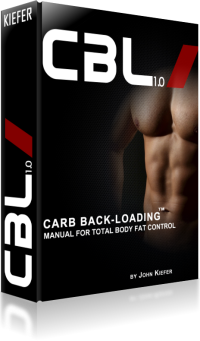About a month ago, I missed a call from Sean Hyson at Men’s Fitness. He left me the following voicemail: “Kiefer, you’ve got to call me back as soon as you can.” Sounding frenzied and a little discombobulated isn’t Sean’s style. He’s a calm, even type of guy, so his message piqued my curiosity and I called him back.
The news? Arnold Schwarzenegger asked about Carb Back-Loading during an audio interview. “What is this carbohydrate back-loading I’ve been hearing about in your magazines?” Can you imagine hearing such a thing? Say it to yourself in Arnold’s voice.
Sean’s been waiting for the green light to publish the interview, but he has to wait for another two weeks before he can do so. He did, however, talk about it in an interview with FitSmart.com, and I suggest you give this a listen, as I did. Unfortunately, I heard some inaccurate statements in the course of the interview, so I commented on the show’s page—as a sort of erratum. One of these statements was that it’s incredibly difficult for the body to convert excess carbs and protein into fat. The problem, however, is that the body can convert carbs into fat storage rather easily, even if conversion directly into fatty acids isn’t easy.
One of the show’s hosts contacted me for more information, and I decided to answer with an article because this is something I think everyone needs to understand.
Can the body convert excess protein into fat?
I thought I’d start here because this is the easiest one, and one I’ve actually seen in a real-life example. No, protein can’t be stored as fat. It’s almost impossible. My real-world example is John Andersen, a guy I spent a few hours talking with last night. At 6’ tall and 280 pounds, John is a shredded beast. His diet? Protein shakes, meat, eggs, a few veggies, and nuts. The vast majority of John’s calories come from protein, and he’s absolutely ripped.
The chemical side of it isn’t as exciting or captivating as seeing John’s results, but it’s worth mentioning all the same. From a biological standpoint, amino acids are very difficult to turn into fatty acids. Only two of the ketogenic amino acids possess a structure capable of forming a fat [1] (a good description of pathways is here), but as you might imagine from their name, they’re more likely to be converted into ketones, which the body clears almost completely through irreversible pathways, i.e. once ketones become metabolized, the chemical products cannot be converted back into energy substrates[2]. These aminos are leucine and lysine (although isoleucine, phenylalanine, threonine and tryptophan could, theoretically become ketones, but are more likely to convert through gluconeogenic pathways).
In contrast, the glucogenic aminos (just about all of them except leucine which is purely ketogenic) could become fatty acids by converting into glucose first through gluconeogenesis[3]. This is an inefficient process, and as I’ll explain below, glucose is also a poor substrate for fatty acid production.
There’s one amino acid that’s worth pointing out as special: glutamine. In studies examining which materials are incorporated into stored fat, it was found that glutamine can contribute as much as 10 percent of the material[4]. Glutamine can be stored within fat cells as part of the lipid complex thus contributing to overall body-fat mass. This was discovered through radioactive marking of the glutamine molecules.
The end result? It almost doesn’t matter how much protein you consume over your daily needs. You won’t store it as body fat, unless, possibly, you ingest a shit-ton of glutamine. Even then, the mechanism (and full extent of storage) isn’t clear, but it clearly requires other raw materials, like carbs.
What about carbs to fat?
This question interests me far more, since many diet experts (including me) claim that carbs make us fat. I’m going to talk primarily about the two monosaccharides of interest: glucose and fructose.
Glucose does not convert easily into fatty acids, although both the liver and fat cells[4-15] will turn glucose into fat through a process called de novo lipogenesis. Even then, the total fat stored from glucose is a small percentage of ingested glucose, less than 5%[4, 11, 13], probably because the process is energetically expensive[20].
Fructose, in contrast, can contribute significantly to de novo lipogenesis when ingested in large quantities, unlike glucose—which has a rate-limited step in the liver preventing it from being stored (as glycogen or fat). Fructose can create unlimited byproducts that lead to the accumulation of fat[16-18]. The body regulates massive feedings with glucose and prevents glucose from sparking lipogenesis[19].
This, however, isn’t the whole story. Carbs can be stored in fat cells in two ways. One could be through the direct conversion of sugar molecules into fatty acids. As I said earlier, this happens, but at a slow rate. Even at a slow rate, it would contribute roughly a pound or more of pure body fat per year, depending on how much body fat you already possess. Where carbs contribute significantly and efficiently to fat storage is through conversion into glycerol complexes[4, 21-23].
Remember, fat cells don’t just suck up fatty acids and hold onto them. They need to be bound together into triaglycerol (TAG) molecules, which are the body’s predominant form of stored energy (fat). This requires three fatty acid molecules and one glycerol. Glucose (and definitely fructose) can easily be converted into glycerol for the storage of more fat.
That’s why when cells are bathed in insulin, both lipoprotein lipase (which pulls fatty acids into cells)[24] and GLUT4 (which pulls glucose into cells) increase on the fat cell’s surface. To store all those fatty acids, the fat cells need glucose to bind the entire complex into TAG. That’s why studies have found that carbs can contribute between 40-70 percent of the stored material in fat cells[4]. And insulin—released in heavy doses when you eat most carbs—partitions more fat into storage than when you eat pure fat.
Glucose (carbs in general) is absolutely necessary for only two tasks: excessive glycogen storage, and excessive fat storage.
Be careful what you overeat.
This is one reason low-fat diets that are predominantly carbs and protein can work for fat loss, although it’s a struggle for your body. At the same time you’re shutting down your body’s ability to mobilize fat, you’re not eating any—and your body needs fat for energy, tissue repair, and health. If you introduce fat into the mix, you store a great deal more than normal.
Protein, on the other hand, is quite a player. You can eat all you want, and you still won’t store it as body fat. Standing next to John Andersen brought this fact home. This guy eats relatively low-fat, massively high-protein, and less than 20 grams of carbs per day—and he’s done this, he says, for nearly seven years.
And guess what? He weighs 280 pounds, and there wasn’t an ounce of fat on him.
What about Fat to Glucose?
There are so many ways to classify fatty acids: essential and non-essential; saturated, unsaturated; trans- or cis-; short-, medium-, or long-chain; and so on. And I’m going to add one more into the mix, odd-chain and even-chain, which, for our discussion is critical.
Even chain fatty acids are those with an even number of carbon atoms on the backbone of the molecule. You’ll see them listed as C8:0, C22:5n3, C10:1n9 and so on. The breakdown in the nomenclature is simple. The ‘C’ means “carbon”, the first number is the number of carbon atoms (sometimes the C is omitted), the second after the colon is the number of unsaturated bonds (so, C8:0 is totally saturated and C22:5 has 5 unsaturated bond between carbons), and the last number after the ‘n’ gives the position of the first unsaturated bond when one exists, labeled from the terminal side of the fatty acid.
Odd-chain fatty acids, as you probably already figured out, have an odd number of carbons. Examples are pentadecanoic acid (C15:0) and heptadecanoic acid (C17:0).
Both of these can be used for oxidative processes. For the ECFAs, it has been stated for decades that the body cannot convert them to glucose[25], but recent observations (such that the brain can depend predominantly on ketones but must still have small amounts of glucose to function[26]), have led to demonstrations of metabolic pathways that could allow for a small amount of glucose production from ECFAs[27]. So it is possible, under states of starvation or heavily ketogenic diets (such as most of the week of Carb Nite) that EFCAs could contribute to glucose production.
OCFAs, on the other hand, we know convert easily into glucose. This is seen readily in animal and human studies where diets rich in even-chains lower blood glucose levels and allow a ketogenic metabolism to take over. An ultra-low carb diet that contains rich amounts of odd-chain fatty acids, however, allows the body to maintain blood glucose levels at the previous amount[28-31]. In other words, an ultra-low carb diet rich in OCFAs, is not ketogenic[31-33]; it’s not much different than a carb-based diet, metabolically that is.
Since animal fats do contain a certain amount of OCFAs (not usually more than 5% total[34]), it’s actually a good reason to eat animal sources for the ability of the OCFAs to supply the small amount of glucose needed for the brain while preserving protein retention.
The Lesson for Carb Back-Loading (and Carb Nite)
The moral of the story isn’t so easy as don’t eat carbs with fat, or make sure every meal is in the perfect zone, 40-30-30 (I can’t even remember what these numbers mean anymore). There is, however, a lesson for back loading your carbs, whether done on Carb Back-Loading or Carb Nite.
If the goal is absolute maximum fat loss, the back loads should be staged with the least amount of fat in the earlier meals and should be “fat back-loaded” during the refeed. Another way of saying this is that the lower-fat your meals are in the first part of the evening, the junkier they can be in the two hours before bed. Theoretically, it shouldn’t make a difference if your last meal of a carb refeed is zero fat or full of fat (Fruity Pebbles with skim milk vs. a whole pizza, respectively), you should wake up leaner and tighter than before. With a couple possible exceptions.
To break the ketogenic cycle, we should use as pure of glucose as possible. For example, immediately post training (or the first meal that breaks the ketogenic part of the diet), we should ingest primarily glucose (not sucrose and not honey, as it’s possible that the disaccharides can be more lipogenic than fructose alone[35]). The body fails to convert glucose into fat at any appreciable rate but we should probably avoid ingesting it with fast-acting fats (like MCT) as this has some potential to increase triglyceride storage.
Again, save the dirtiest treats—my favorites, like cherry turnovers—for the last meal because of the fat content wrapped up with the disaccharide sugar load. Although these may, theoretically, aid lipogenesis, the insulin load is worth the small amount that might be converted to fat or stored in fat cells.
Synopsis
I hope, if nothing else, this demonstrates how naïve it is to use universal qualifiers with macro-nutrients. Not all carbs act the same in the body; neither do all fats and neither do all proteins (although that’s another subject). The type you eat can make a massive difference. For example, simply assuming that any ultra-low carb diet is instantly ketogenic is false. Thinking you can’t gain fat if you eat only carbs, is absolutely false. The type, timing and combination with other nutrients is what matters, absolutely.
References (click to expand)
- Mitchell GA, Kassovska-Bratinova S, Boukaftane Y, Robert MF, Wang SP, Ashmarina L, Lambert M, Lapierre P, Potier E. Medical aspects of ketone body metabolism. Clin Invest Med. 1995 Jun;18(3):193-216.
- Barton RN. The interconversion and disposal of ketone bodies in untreated and injured post-absorptive rats. Biochem J. 1973 Nov;136(3):531-43.
- Schutz Y. Protein turnover, ureagenesis and gluconeogenesis. Int J Vitam Nutr Res. 2011 Mar;81(2-3):101-7.
- Collins JM, Neville MJ, Pinnick KE, Hodson L, Ruyter B, van Dijk TH, Reijngoud DJ, Fielding MD, Frayn KN. De novo lipogenesis in the differentiating human adipocyte can provide all fatty acids necessary for maturation. J Lipid Res. 2011 Sep;52(9):1683-92.
- Collins JM, Neville MJ, Hoppa MB, Frayn KN. De novo lipogenesis and stearoyl-CoA desaturase are coordinately regulated in the human adipocyte and protect against palmitate-induced cell injury. J Biol Chem. 2010 Feb 26;285(9):6044-52.
- Wilke MS, French MA, Goh YK, Ryan EA, Jones PJ, Clandinin MT. Synthesis of specific fatty acids contributes to VLDL-triacylglycerol composition in humans with and without type 2 diabetes. Diabetologia. 2009 Aug;52(8):1628-37.
- Roberts R, Hodson L, Dennis AL, Neville MJ, Humphreys SM, Harnden KE, Micklem KJ, Frayn KN. Markers of de novo lipogenesis in adipose tissue: associations with small adipocytes and insulin sensitivity in humans.Diabetologia. 2009 May;52(5):882-90.
- Chong MF, Hodson L, Bickerton AS, Roberts R, Neville M, Karpe F, Frayn KN, Fielding BA. Parallel activation of de novo lipogenesis and stearoyl-CoA desaturase activity after 3 d of high-carbohydrate feeding. Am J Clin Nutr. 2008 Apr;87(4):817-23.
- Strawford A, Antelo F, Christiansen M, Hellerstein MK. Adipose tissue triglyceride turnover, de novo lipogenesis, and cell proliferation in humans measured with 2H2O. Am J Physiol Endocrinol Metab. 2004 Apr;286(4):E577-88.
- Minehira K, Bettschart V, Vidal H, Vega N, Di Vetta V, Rey V, Schneiter P, Tappy L. Effect of carbohydrate overfeeding on whole body and adipose tissue metabolism in humans. Obes Res. 2003 Sep;11(9):1096-103.
- Guo ZK, Cella LK, Baum C, Ravussin E, Schoeller DA. De novo lipogenesis in adipose tissue of lean and obese women: application of deuterated water and isotope ratio mass spectrometry. Int J Obes Relat Metab Disord. 2000 Jul;24(7):932-7.
- Hellerstein MK, Neese RA, Schwarz JM. Model for measuring absolute rates of hepatic de novo lipogenesis and reesterification of free fatty acids. Am J Physiol. 1993 Nov;265(5 Pt 1):E814-20.
- Shrago E, Spennetta T. The carbon pathway for lipogenesis in isolated adipocytes from rat, guinea pig, and human adipose tissue. Am J Clin Nutr. 1976 May;29(5):540-5.
- Bray GA. Lipogenesis in human adipose tissue: some effects of nibbling and gorging. J Clin Invest. 1972 Mar;51(3):537-48.
- Mellati AM, Beck JC, Dupre J, Rubinstein D. Conversion of glucose to lipid by human adipose tissue in vitro. Metabolism. 1970 Nov;19(11):988-94.
- Mayes PA. Intermediary metabolism of fructose. Am J Clin Nutr. 1993 Nov;58(5 Suppl):754S-765S.
- Schwarz JM, Neese RA, Schakleton C, Hellerstein MK. De novo lipogenesis during fasting and oral fructose ingestion in lean and obese hyperinsulinemic subjects. Diabetes 1993;42(suppl):A39.
- Schwarz J-M, Neese RA, Turner SM, Nguyen C, Hellerstein MK. Effect of fructose ingestion on glucose production (GP) and de novo lipogenesis (DNL) in normal and hyperinsulinemic obese humans. Diabetes 1994;43(suppl):52A.
- Hellerstein MK, Schwarz JM, Neese RA. Regulation of hepatic de novo lipogenesis in humans. Annu Rev Nutr 1996;16:523–57.
- Leitch CA, Jones PJH. Measurement of triglyceride synthesis in humans using deuterium oxide and isotope ratio mass spectrometry. Biol Mass Spectrom. 1991;20:392–6.
- Goldrick RB, McLoughlin GM. Lipolysis and lipogenesis from glucose in human fat cells of different sizes. Effects of insulin, epinephrine, and theophylline. J Clin Invest. 1970 Jun;49(6):1213-23.
- Maruhama Y. Conversion of ingested carbohydrate-14C into glycerol and fatty acids of serum triglyceride in patients with myocardial infarction. Metabolism. 1970 Dec;19(12):1085-93.
- Barter PJ, Nestel PJ, Carroll KF. Precursors of plasma triglyceride fatty acid in humans. Effects of glucose consumption, clofibrate administration, and alcoholic fatty liver. Metabolism. 1972 Feb;21(2):117-24.
- Zechner R, Kienesberger PC, Haemmerle G, Zimmermann R, Lass A. Adipose triglyceride lipase and the lipolytic catabolism of cellular fat stores. J Lipid Res. 2009 Jan;50(1):3-21.
- de Figueiredo LF, Schuster S, Kaleta C, Fell DA. Can sugars be produced from fatty acids? A test case for pathway analysis tools. Bioinformatics. 2009 Jan 1;25(1):152-8.
- Owen OE, Smalley KJ, D’Alessio DA, Mozzoli MA, Dawson EK. Protein, fat, and carbohydrate requirements during starvation: anaplerosis and cataplerosis. Am J Clin Nutr. 1998 Jul;68(1):12-34.
- Kaleta C, de Figueiredo LF, Werner S, Guthke R, Ristow M, Schuster S. In silico evidence for gluconeogenesis from fatty acids in humans. PLoS Comput Biol. 2011 Jul;7(7):e1002116.
- Anderson RL, Volpenhein RA. Carcass Deposition of Dietary Long-Chain Odd Carbon Fatty Acids by Rats and Their Effect on Plasma Glucose and Ketone Bodies During Starvation. J Nutr. 1979 Oct;109(10):1810-4.
- Ekman L, Wretlind A, Moldawer L. New developments in lipid emulsions for parenteral nutrition. Infusionsther Klin Ernahr. 1987 Sep;14 Suppl 3:4-8.
- Anderson RL, Boggs RW. Glucogenic and ketogenic capacities of lard, safflower oil, and triumdecanoin in fasting rats. J Nutr. 1975 Feb;105(2):185-9.
- Pi-Sunyer FX. Resistance to ketosis during prolonged fasting by rats fed on a diet containing undecanoic acid, an odd-carbon-number fatty acid. Br J Nutr. 1976 Jan;35(1):41-6.
- Kim S, Pi-Sunyer FX. Diminished ketosis and triglyceridemia during fasting in odd-carbon enriched pregnant rats. Endocrinology. 1977 Feb;100(2):373-9.
- Pi-Sunyer FX, Conway JM, Lavau M, Campbell G, Eisenstein AB. Glucagon, insulin, and gluconeogenesis in fasted odd carbon fatty acid-enriched rats. Am J Physiol. 1976 Aug;231(2):366-9.
- Tagliamonte B, Tomassi G. Fatty acids with an odd number of carbon atoms: metabolic and nutritional aspects. S TA NU. 1976 Jan-Feb;6(1):7-12. Review.
- Thompson RG, Hayford JT, Hendrix JA. Triglyceride concentrations: the disaccharide effect. Science. 1979 Nov 16;206(4420):838-9.











Recent Comments